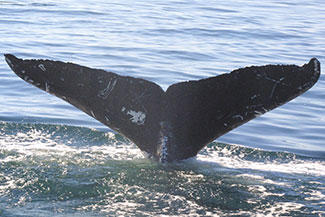Photo-Identification
Most whale species have a feature that is unique to individuals. By photographing these features over time, researchers are able to track the life or sighting histories of whales over many years. These sighting histories help researchers to know how many whales are utilizing various habitats and feeding grounds, as well as how they have a calf and where they migrate to breed. Photo-ID is the backbone of GAP whale research efforts due to the wealth of information photographs can provide.
Humpback whales are identified by the ventral surface of their tail flukes, which they show prior to deep dives.


The GAP photo-ID effort for humpback whales began in 1999. To date, the Kodiak catalog of humpback whales contains over 1,100 individual whales and we have matched individuals to three of the four North Pacific breeding grounds.
Individual fin whales are identified by the shape, scars, and nicks on their dorsal fins, as they rarely show their flukes.


The effort to photograph fin whales began in 2001, but has not been as consistent as the humpback whale effort. Individuals are much harder to identify and a very high quality photograph is required. Despite these obstacles, we have cataloged over 150 individual fin whales and have begun to resight individuals across years.
Gray whales are identified by their tail flukes, as well as their dorsal flanks (since gray whales have no dorsal fin!).


Directed efforts to photograph gray whales occurred in 2008 and 2010. In 2008, 24 individuals were photographed and 27 were photographed in 2010. From this collection, 4 individuals were matched to the Pacific Coast Feeding Group [PDF] of gray whales.
See Metadata for GAP: Feeding and seasonality of gray whales in Ugak Bay; Kodiak Island Alaska 2008-2011 [PDF].


